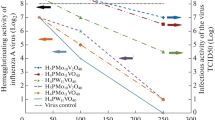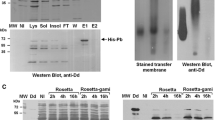Summary
Purified soluble hexon antigens of type 5, 7, and 8 adenoviruses, belonging to three different subgroups have been studied. The electrophoretic mobility of the three hexons was found to be different in immunoelectrophoresis, and the calculation of absolute electrophoretic mobility gave different values too. Significant dissimilarities were observed in the elution patterns of the hexons in anionexchange chromatography. However, no essential differences between the molecular weights of the hexons were demonstrable, they appeared to be with all three types about 300,000.
Determination of the smallest hexon quantities demonstrable by immunodiffusion, immuno-osmophoresis and complement fixation (CF) reaction, showed the CF reaction to be the most sensitive. 0.02 μg of type 5 and type 8 hexons and 0.08 μg of type 7 hexon were detectable using homologous anti-hexon sera. The anti-hexon sera neutralized the cytopathic effect of the homologous adenovirus types only. In the immunodiffusion experiments any two antigens of the three proved to be identical, examined with the third (heterologous) serum. Using homologous serum they revealed only a partial identity. Absorption experiments were successful only when homologous antigen was used, even excess amount of heterologous hexons failed to remove the antibodies from the anti-hexon sera.
These results demonstrate the presence of closely connected group-, subgroup or type-specific components in the hexons of adenoviruses, and definite differences in the physico-chemical properties of hexons belonging to different serotypes.
Similar content being viewed by others
References
Backhausz, R.: Immundiffusion und Immunelektroforese. Publishing House of the Hung. Acad. Sci., Budapest (1967).
Barski, G., etF. Cornefert: Aspects dinstinctifs des lésions cellulaires causéesin vitro par différents types d'adénovirus. Ann. Inst. Pasteur94, 724–731 (1958).
Döhner, L.: Untersuchungen zum Nachweis von serologischen Unterschieden zwischen den Gruppenantigenen aus verschiedenen Adenovirustypen. Z. Immunforsch.136, 404–414 (1968).
Graber, P., J. Uriel, etJ. Courcon: L'analyse immunoéléctrophorétique du sérum humain normal VI. Mobilités électrophorétiques. Ann. Inst. Pasteur99, 13–27 (1960).
Hollinshead, A. C., andR. J. Huebner: Isolation and analysis of adenovirus 12 sub-units from adenovirus 12 infected cells. Nature (Lond.)211, 890–891 (1966).
Jawetz, E., L. Hanna, A. Nicholas, andR. Hoyt: Some biological characteristics of adenovirus type 8. Amer. J. Hyg.67, 276–285 (1958).
Köhler, K.: Reinigung und Charakterisierung zweier Proteine des Adenovirus Typ 2. Z. Naturforsch.20b, 747–752 (1965).
Lengyel, A., andI. Nász: Soluble components of adenovirus type 8. J. Virol.6, 406–414 (1970).
Lowry, O. H., N. J. Rosebrough, A. L. Farr, andR. J. Randall: Protein measurment with the Folin phenol reagent. J. biol. Chem.193, 265–275 (1951).
Loytved, D., undR. Wigand: Cytologische Untersuchungen an HeLa-Zellen nach Infektion mit Adenoviren der Gruppe II. Z. med. Mikrobiol. Immunol.154, 277–286 (1969).
Macintyre, W. M., H. G. Pereira, andW. C. Russel: Crystallographic data for the hexon of adenovirus type 5. Nature (Lond.)222, 1165–1166 (1969).
Maizel, J. V. Jr., D. O. White, andM. D. Scharff: The polypeptides of adenovirus. II. Soluble proteins, cores, top components and the structure of the virion. Virology36, 126–136 (1968).
Nász, I.: Differences in the cytopathogenic effect of some adenovirus strains on human amniotic tissue cultures. Acta microbiol. Acad. Sci. hung.8, 397–403 (1961).
Nász, I.: Some biological characteristics of adenovirus type 8 strains. Acta microbiol. Acad. Sci. hung.10, 355–363 (1963).
Nász, I.: Immuno-osmophoresis and adenoviruses. Lanceti, 394–395 (1967).
Nász, I., I. Cserba, andK. Rózsa: Study of adenovirus type 5 antigens by immuno-osmophoresis. Z. Immunforsch.134, 225–234 (1967).
Nász, I., G. Kulcsár, P. Dán, A. Lengyel, andI. Cserba: Studies on the aetiology of epidemic keratoconjunctivitis observed in Budapest during winter 1961 –1962 Acta microbiol. Acad. Sci. hung.10, 35–40 (1963).
Nász, I., andH. G. Pereira: Study of the antigens of a new oncogenic adenovirus strain fractionated by different methods. Proc. of the Fourth Congr. Hung. Assoc. Microbiol. Publishing House of the Hung. Acad. Sci., Budapest, p. 205 (1966).
Norrby, E.: Biological significance of structural adenovirus components. Curr. Top. Microbiol. Immunol.43, 1–43 (1968).
Norrby, E.: The structural and functional diversity of adenovirus capsid components. J. gen. Virol.5, 221–236 (1969).
Norrby, E.: The relationship between the soluble antigens and the virion of adenovirus type 3. IV. Immunological complexity of soluble components. Virology37, 565–576 (1969).
Norrby, E., andG. Wadell: Immunological relationships between hexons of certain human adenoviruses. J. Virol.4, 663–670 (1969).
Pettersson, U., L. Philipson, andS. Höglund: Structural proteins of adenoviruses. I. Purification and characterization of the adenovirus type 2 hexon antigen. Virology33, 575–590 (1967).
Potter, C. W., J. S. Oxford, andB. C. McLaughlin: A comparison of adenovirus 12 induced T and tumour antigens by rate-zonal centrifugation. J. gen. Virol.6, 105–116 (1970).
Rosen, L.: A hemagglutination-inhibition technique for typing adenoviruses. Amer. J. Hyg.71, 120–128 (1960).
Saphiro, A. L., E. Vinuela, andJ. V. Maizel, Jr: Molecular weight estimation of polypeptide chains by electrophoresis in SDS-polyacrylamide gels. Biochem. biophys. Res. Commun.28, 815–820 (1967).
Shortridge, K. F., andF. Biddle: The proteins of adenovirus type 5. Arch. ges. Virusforsch.29, 1–24 (1970).
Valentine, R. C., andH. G. Pereira: Antigens and structure of the adenovirus. J. molec. Biol.13, 13–20 (1965).
Wadell, G.: Structural and biological properties of capsid components of human adenoviruses. D. Broberg, Stockholm, 1–39 (1970).
Whitaker, J. R.: Determination of molecular weights of proteins by gel filtration on Sephadex. Anal. Chem.35, 1950–1953 (1963).
Wilcox, W. C., andH. S. Ginsberg: Production of specific neutralizing antibody with soluble antigens of type 5 adenovirus. Proc. Soc. exp. Biol. (N.Y.)114, 37–42 (1963).
Author information
Authors and Affiliations
Rights and permissions
About this article
Cite this article
Nász, I., Lengyel, A. & Cserba, I. Comparative studies of adenovirus hexon antigens. Archiv f Virusforschung 36, 80–92 (1972). https://doi.org/10.1007/BF01250298
Received:
Issue Date:
DOI: https://doi.org/10.1007/BF01250298




